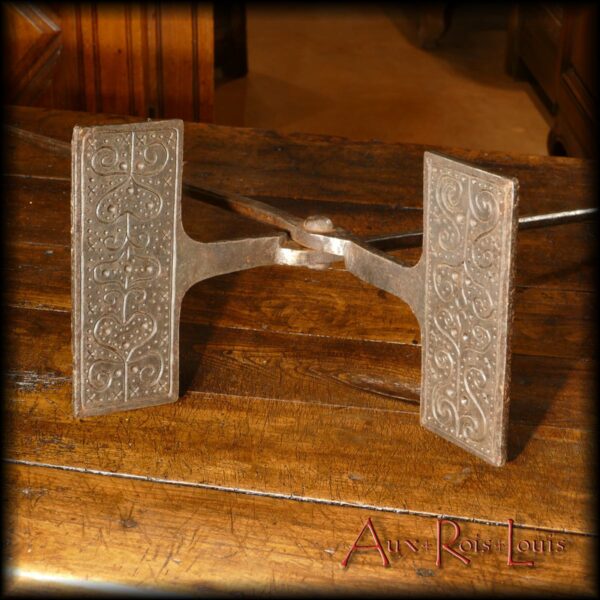Globular Melard with Spout – 18th Century – Puy de Dôme – [PA088]
Presenting a splendid mélard originating from an Auvergne pottery centre in the 18th century. It was suspended in a pantry for the convenient pouring of precious walnut oil, commonly used for lighting during that era.

![Globular Melard with Spout – 18th Century – Puy de Dôme – [PA088] This globular mélard with pinched spout, an intermediary size between the large mélard and the oil jug, was meant to be suspended. Its base is rounded for this purpose, to ensure the attachment of a rope without sharp angles. The rope passing under the bottom was held from bottom to top against the pottery's belly by another transverse rope passing under the specially flared neck. The whole was suspended from a beam resembling a joist. This mélard is covered with a green glaze and a lead cover, two finishes intended to provide it with brilliance and waterproofing. Its decoration consists of finger-molded bands. The facade is adorned with a cross motif placed under the pinched spout. This reduced spout allowed for a faster, smoother flow.](https://www.aux-rois-louis.com/wp-content/uploads/2024/02/PA088_P1680256-600x600.webp)
![Peasant Crowned Jug – 17th Century – Auvergne – [PA086] Here is a charming oil jug crafted in the workshop of peasant potters in Brioude, Auvergne, France, in the 17th century. It is adorned with a crown-shaped motif around the summit opening, a detail envisioned by the peasant who shaped it with precision and, clearly, with love too.](https://www.aux-rois-louis.com/wp-content/uploads/2024/01/PA086_P1680261-600x600.webp)
![Glazed Terracotta Oil Barrel – 19th Century – Saintonge – [PA080] This oil barrel comes from the renowned pottery center of La Chapelle-des-Pots, located in the former province of Charentes, known as Saintonge. Exclusively in Saintonge, from the Middle Ages onward, these barrel-shaped potteries were crafted using the beautiful local clay, reserving walnut oil for the lighting of each household.](https://www.aux-rois-louis.com/wp-content/uploads/2023/11/PA080_P1670098-600x600.webp)
![Peasant Water Jug in Glazed Terracotta – 19th Century – Auvergne – [PA078] This glazed terracotta water jug comes from a countryside workshop in Brioude, Haute-Loire, France. This type of Auvergnat pottery workshop operated only in winter when farmers were free from fieldwork. The clay is red due to its natural iron oxide content. This raw clay was grogged, meaning it was mixed with river sand and crushed fired clay.](https://www.aux-rois-louis.com/wp-content/uploads/2023/12/PA078_P1670085-600x600.webp)

![Petrified Oil Jar – 19th Century – Saintonge / Charente – [PA077] Statufied and adorned with an emerald scarf, its gentle belly fears no ravages of time. On the contrary, it enhances it, turning this Charente pottery into a star jar, or dare I say, an authentic oil of the upscale districts.](https://www.aux-rois-louis.com/wp-content/uploads/2023/07/PA077_P1660669-600x600.webp)
![Mélard in White Clay and Suspended Mélard – [PA073] [PA074] – 18th century – Cantal Two walnut oil jugs, fuel used in the 18th century for lighting. The mélard on the left is in raw white clay on which concretions come from the interior. The mélard on the left benefited from a water-green glaze which made it waterproof. Its two handles allow it to be hung on a rope to be able to lean it and thus facilitate the flow of oil.](https://www.aux-rois-louis.com/wp-content/uploads/2022/10/PA073_PA074_P1660311-600x600.webp)

![Imperial oil jug – 19ᵗʰ century – Quercy – [PA072]](https://www.aux-rois-louis.com/wp-content/uploads/2022/04/PA072_P1660219x1200-600x600.jpg)
![Terracotta ham pot – 19th century – Charente – [PA067]](https://www.aux-rois-louis.com/wp-content/uploads/2022/02/PA067_715-600x600.jpg)
![Three terracotta melards – orange, green and yellow – 19th century – Puy-de-Dôme – [PA064 PA065 PA066]](https://www.aux-rois-louis.com/wp-content/uploads/2022/01/PA064_65_66_673-600x600.jpg)
![Two oil jugs - late 18th century early 19th century - Lot Valley, Quercy - [PA062] [PA063]](https://www.aux-rois-louis.com/wp-content/uploads/2021/12/PA062-63_P1650160-600x600.jpg)
![Two water jugs - 19th century - Lot Valley - [PA058] [PA059]](https://www.aux-rois-louis.com/wp-content/uploads/2021/12/PA058_59_094x900-600x600.jpg)
![Two water jugs – 19th century – Les Landes – [PA060] [PA061]](https://www.aux-rois-louis.com/wp-content/uploads/2021/11/PA060_61_099x900-600x600.jpg)
![Three water jugs – 19th century – Périgord – [PA055] [PA056] [PA057]](https://www.aux-rois-louis.com/wp-content/uploads/2021/10/PA055-56-57_P1600970-600x600.jpg)
![Two oil jugs - 19ᵗʰ century - Périgord - [PA053] [PA054]](https://www.aux-rois-louis.com/wp-content/uploads/2021/10/PA053-54_P1600961-600x600.jpg)



![PA044_P1600318 Oil jar – 19ᵗʰ century – Quercy – [PA044]](https://www.aux-rois-louis.com/wp-content/uploads/2021/02/PA044_P1600318-600x600.jpg)

![PA036_PA037_617c Two water jugs - 19ᵗʰ century - Midi-Pyrénées [PA036] [PA037]](https://www.aux-rois-louis.com/wp-content/uploads/2020/08/PA036-037_617c-600x600.jpg)






![Pitcher – 19ᵗʰ century – Auvergne Pitcher – 19ᵗʰ century – Auvergne – [PA009]](https://www.aux-rois-louis.com/wp-content/uploads/2022/07/PA009_N009_P1340559c1200-1-600x600.webp)
![Oil jar – 18ᵗʰ century – Auvergne Oil jar – 18ᵗʰ century – Auvergne – [PA008]](https://www.aux-rois-louis.com/wp-content/uploads/2022/07/PA008_N008_P1340558c1200-600x600.webp)

![Oil jar – Early 19ᵗʰ century – Quercy Oil jar – Early 19ᵗʰ century – Quercy – [PA015]](https://www.aux-rois-louis.com/wp-content/uploads/2022/07/PA015_N001_P1330488c800-600x600.webp)

